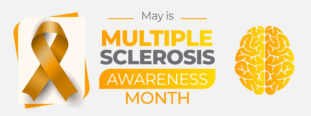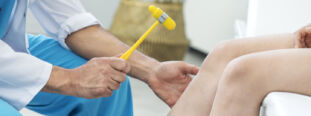Bladder problems: three medication options
Bladder problems affect most people with MS at some point in the course of the disease, often in conjunction with other MS symptoms. The most common bladder problems are urgency, incontinence, and difficulties emptying the bladder, which can mean running back and forth to the bathroom or needing to get up in the middle of the night. These difficulties go by various names (e.g. detrusor overactivity, sphincter dyssynergia), but really boil down to two main concerns: problems with storing normal amounts of urine in the bladder, and problems fully emptying the bladder.
As with most things MS-related, the problem doesn’t originate in the bladder but in the brain, in what is called the “micturition centre”. If an inflammatory MS lesion affects this area of the brain, it will have an impact on the nerves and muscles that regulate bladder function. So there is a disconnect between brain and bladder: the bladder muscles contract instead of relaxing, so you can’t store as much urine and need frequent trips to the bathroom or feel a sudden urgency; you get the message that your bladder is empty when a lot of urine still remains; the bladder may want to empty but the sphincter (which controls the flow) isn’t cooperating, so there’s a dribble instead of a full stream; and so on. These problems can cause complications, such as bladder infections, but more serious kidney problems are fortunately rare (Litwiller and colleagues. J Urol 1999;161:743-757).
Bladder symptoms need to be investigated by a urologist to determine the exact nature and extent of the problem. There are three main types of medication that can be used to treat bladder symptoms. Exploring different options may be needed because a given drug may not be fully effective. The medications are:
1. Anticholinergic drugs (also called antimuscarinics). These are typically the first-choice medications for bladder problems. Examples are tolterodine (Detrol), oxybutynin (Ditropan, Lyrinel, Lenditro), darifenacin (Enablex, Emselex). These medications block the neurotransmitter acetylcholine, which relieves muscle spasms in the bladder. This type of medication is to treat frequent urination and incontinence. Possible side effects include dry mouth, blurred vision, constipation, dizziness and drowsiness. People with eye conditions such as glaucoma should avoid these drugs.
While these drugs are widely used in MS, few scientific studies have been done; the available results are a bit mixed (Nicholas and colleagues. Cochrane Database Syst Rev 2009 Jan 21;(1):CD004193). One Canadian study found that tolterodine and oxybutynin were similarly effective in improving bladder capacity and reducing the number of episodes of incontinence (Ethans and colleagues. J Spinal Cord Med 2004;27:214-218). For people who don’t respond that well, higher doses or using more than one drug may be helpful (Bennett and colleagues. J Urol 2004;171[2 pt 1]:749-751; Amend and colleagues. Eur Urol 2008;53:1021-1028). But a concern with this approach is that these medications can impair cognition and may be associated with neurological symptoms in people with MS (Vaidyanathan and colleagues. Spinal Cord 1997;35:190-191). So caution is needed. One analysis found that cognitive function (thinking, planning, etc.) was less impaired with darifenacin (Kay & Ebinger. Int J Clin Pract 2008;62:1792-1800, so this may be a better option for some.
2. Botox (onabotulinumtoxin A). This involves periodic injections into the bladder wall muscle (called the detrusor) to reduce the symptoms of an overactive bladder. The beneficial effects last about 9 months.
A number of recent studies have reported a high degree of success with this treatment (Cruz and colleagues. Eur Urol 2011;60:742-750; Khan and colleagues. J Urol 2014;185:1344-1349). For example, a pooled analysis of two phase III studies found that the number of incontinence episodes declined dramatically, from an average 4-5 per week to about once a week (Ginsberg and colleagues. Adv Ther 2013;30:819-833; free full text at www.ncbi.nlm.nih.gov/pmc/articles/PMC3824824/pdf/12325_2013_Article_54.pdf ). The number of voluntary trips to the bathroom was also significantly reduced. About one-half of the people were also taking an anticholinergic medication.
The beneficial effects of the injections last about 9 months (Schurch & Carda. Ann Phys Rehabil Med 2014; epublished June 5, 2014). Side effects appear to be minimal. However, a possible complication is that the formerly overactive bladder is now so relaxed that you’ll retain urine. So it’s generally advised to perform self-catheterization; this involves inserting a plastic tube into the urethra to drain the urine (which can be a bit uncomfortable but not painful). Some people also suggest taking antibiotics to guard against the higher risk of developing a bladder infection (Schurch 2014).
3. Cannabinoids. This group of marijuana-derived substances includes tetrahydrocannabinol (THC) and cannabidiol (CBD). The appeal lies in their interactions with cannabinoid receptors (CB1, CB2); CB1 is found primarily in the brain, but both CB1 and CB2 are also located in the bladder and urethra (Ruggieri MR Sr. Handb Exp Pharmacol 2011;425-51). One suggestion is that cannabinoids may be able to interact with nerve fibres (which express CB receptors) in the bladder to reduce bladder pain and urgency (Mukerji and colleagues. Urology 2010;75:1514).
An early study found some benefit with a THC/CBD spray (Brady and colleagues. Mult Scler 2004;10:425-433), although there was a suggestion that people urinated less often because they were drinking less water. The largest study, the Cannabinoids in MS (CAMS) trial, found that a THC extract had no impact on bladder symptoms, although people wrote in their diaries that there were some improvements (Freeman and colleagues. Int Urogynecol J Pelvic Floor Dysfunc 2006;17:636-641).
Most recently, the American Academy of Neurology looked at all the evidence and concluded that THC and oral cannabinoid extracts are probably ineffective for bladder problems (Koppel and colleagues. Neurology 2014;82:1556-1563). The AAN also decided that Sativex, a THC/CBD mouth spray, is probably effective in reducing the number of urinations in a day, although the one study that’s been done found that the benefits were minimal at best (Kavia and colleagues. Mult Scler 2010;16:1349-1359).
Share this article
Facebook Twitter pin it! Email
Related Posts
Back





